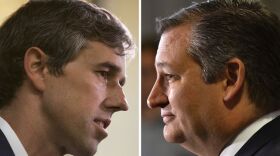Williamson County is leading the state when it comes to the percentage of registered voters casting ballots in-person during the first two days of early voting. Experts say that's a sign political groups are paying more attention to suburban counties near major cities across the U.S.
Christopher Davis, the elections administrator for Williamson County, said the county “is taking a lead statewide when it comes to in-person voting.”
“It’s definitely something different,” he said.
According to the Texas Secretary of State’s figures, almost 12 percent of registered voters in the county voted in just the first two days of early voting. That’s more than in any major county in the state.
During the last midterm elections in 2014, Davis said, only about 8,600 people had voted at this point. So far this election, the number of voters has more than quadrupled – to over 39,600.
"Is it a suburb of Austin where people who want to be close to Austin ... live? Or is it a place where people live to explicitly reject Austin, but still live close to things that cities provide?"
Joshua Blank, manager of polling and research at the Texas Politics Project at UT Austin, said a couple of forces could explain this turnout. For one, he said, Williamson is the sort of county that’s getting a lot of attention from political parties across the country.
“It's a Republican-held district on the outskirts of a liberal-urban core that also has a lot of suburban Republican voters,” he said.
Blank said that means races are getting more competitive in the county, which is driving more political spending from local and national groups.
Williamson County has also seen a population boom in the past couple years. But how, or whether, that growth has changed this traditionally Republican county, is an open question.
“I think the election will tell us a lot about the political leanings of Williamson County,” Blank said.
The county has experienced an influx of people moving from Austin – presumably forced by rising home prices. But Blank said it’s not a given that they have made the county more liberal.
Despite that population growth, he said, Williamson has stayed pretty conservative in past elections.
“I think the thing about a place like Williamson and all the growth is: On the one hand, is it a suburb of Austin where people who want to be close to Austin … live?” he asked. “Or is it a place where people live to explicitly reject Austin, but still live close to things that cities provide?”
With high turnout, Blank said, this election could provide better answers.
Overall though, he said, what's happening in Williamson is part of a larger population shift in the country that is changing politics.
“Historically, these suburban counties used to be hotbeds of Republican voters, but as the cities have gotten bigger and pushed more and more people – and more diverse people — out into the suburbs, it is creating more competition in those areas.”





